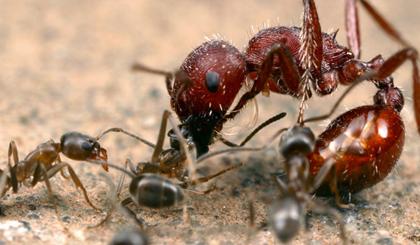Photo Credit: Alex Wild

Argentine ants, those nasty invaders of homes around the world, have yielded their innermost secrets to an international team of biologists who have deciphered their genetic code, revealing new clues to their evolution, their social lives - and perhaps to their ultimate defeat as pests.
Led by scientists at San Francisco State University and UC Berkeley, scores of gene hunters joined in what amounted to an Ant Genome Project - a smaller-scale version of the Human Genome Project that was completed a decade ago.
This week, four groups of biologists and ant geneticists are announcing that they have completed draft sequences for the Argentine ant, the huge red harvester ant, the vicious stinging fire ant and the peaceful, fungus-farming leaf-cutter ant. Their reports appear in the Proceedings of the National Academy of Sciences and PloS, the Public Library of Science.
Homeowners around the world are probably most familiar with tiny brown Argentine ants, which year after year and time after time invade their cupboards and countertops looking for morsels of food.
"We now have blueprints for understanding the genetic basis of behavior in the Argentine ants," said Christopher D. Smith, a molecular biologist at San Francisco State. "We've found the genes for determining their development as queens and worker ants, for how queen ants produce chemicals that prevent ant larvae from developing into adults, and for their resistance to toxic chemicals."
Map to an ant's world
He and evolutionary biologist Neil D. Tsutsui of UC Berkeley led the group that mapped the genes of the Argentine ants; they also joined scores of other scientists in the other projects.
The new genome map for the Argentines, Tsutsui said, provides "a huge resource for understanding the evolution of their social behavior, the roots of their influence on their worldwide ecology and, of course, the potential for discovering benign new targets to control their disruptive invasions."
The Argentine ants devastate other insect communities vital to pollination and biodiversity and have resisted all efforts to exterminate them. They form huge colonies of genetically identical ants. In California, one colony stretches from San Diego to Oregon. Its members attack and eat every other insect in their surrounding regions, including ants much larger than they are, like the red harvesters.
Red harvesters are extremely large, aggressive ants that can bite. Fire ants not only bite humans, but have evolved to kill small animals. The peaceable leaf-cutters are the most social of all ants. They collect pieces of leaves to nourish the fungus they cultivate inside their nests.
Researchers believe they'll learn to understand these ant groups' behaviors and evolutions by studying their genomes.
'Important new tools'
Brian Fisher, an entomologist at the California Academy of Sciences and an international expert on ant biology, expressed enthusiasm for the genome projects, saying they could ultimately lead to the development of environmentally benign ant control and new approaches to human health.
"Understanding these ant genes in minute detail will give us important new tools of all kinds," he said. "For example, we know that ants are chemical factories - they talk to each other with chemicals; they make chemicals for resisting bacteria and fungi; they produce antimicrobial chemicals and others that detoxify poisons.
"Knowing their genome, I believe, means that eventually those genes enabling Argentine ants to resist diseases may lead to ways for improving human resistance to all kinds of human diseases."
Smith cautioned that knowing the genome of the ant species does not mean that scientists will quickly find "magic bullets" for controlling the pests, let alone improve human health.
"In reality, the genome is really just information and now we have to put it into action by manipulating the ants to confirm if a target gene does what we think it does," he said.
Read it at the source
